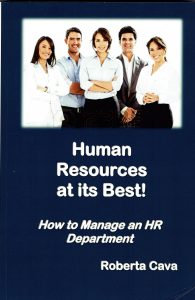Last month we discussed: Applying for a Job. This month we will discuss Roberta Cava’s information about: Equal pay for work of equal value excerpts from her book: Human Resources at its Best.

EQUAL PAY FOR WORK OF EQUAL VALUE
Worldwide, much effort has been put into dealing with gender bias in job evaluation systems. Many countries have found that legislative rulings were necessary to eliminate gender bias from the job evaluation process. Before this was implemented many women found:
- Gender-stereotyping which could result in the under-evaluation of female-held positions.
- Many evaluations of female-held positions underestimated the importance of the skills and qualities required.
In Canada, the following laws have been in place for decades, but there are still serious discrepancies between the salaries of men and women doing essentially the same work in Australia. Here are some of the issues that are laws in Canada:
Equal pay for work of equal value: This compares cooks vs. chefs; cleaning ladies vs. janitors for instance and ensures that if men and women are doing essentially the same kind of task – regardless of the title – they must be paid the same.
Employment Equity:
This relates to anti-discrimination and equal opportunity laws that protect minorities from discrimination.
Pay Equity
Is a system that determines the value of the position as it compares to that of others in the company. It compares ‘apples against oranges’ or ‘accountants, engineers, production people, caretakers, personal assistants and managers’ against the value of all other employees in the company. Australia has yet to implement these laws.
Pay equity uses job descriptions to see if the positions have been evaluated properly and given equitable salary ranges to meet the requirements of the position. It examines such things as working conditions, knowledge, experience, education etc. and gives points for each of these. This way companies can compare all positions in their company. All companies are encouraged to be ready for these changes. Under pay equity laws, companies are required to have an evaluation system that’s used to evaluate even the highest position in the company against the value of the lowest and determine salary ranges to suit the work performed.
To make pay equity work, all job descriptions require that all tasks are described clearly (i.e. detailed, quantitative and measurable). To accomplish this, standards of performance will be required to explain how each task is performed.
Classification of Positions
The first step in evaluating a position is the preparation of an accurate up-to-date job description which clearly states the responsibility, authority and qualifications required to fill the position. Next the position is graded against an established rating which determines the value of each factor as it relates to the needs of the position. Points are allotted to the above grades and the total point score of the position determines the salary range for the position. This way, accountants can be compared with engineers, and secretaries with custodians.
There are many forms of classification systems. The most popular in North America are the Hay and Kellogg systems. These are systems where every position in a company can be compared against a factor system that ensures fair payment for work performed (pay equity).
These systems evaluate (with points) the comparative worth of every position. Each factor determines the level required for each position to be effectively filled by an employee. It does not consider gender, race or colour – just the requirements of the position. These factors evaluate such things as:
Knowledge and Ability:
1. Complexity – Judgement
2. Education
3. Experience (related)
4. Initiative (Independent action)
Responsibilities:
1. Errors (consequences of)
2. Contacts (level)
3. Supervision – (responsibility level)
4. Supervision – Scope (how many)
Physical Conditions:
1. Physical Demands
2. Working Conditions
When those factors are determined and the value of the contribution made by the employee in the position is determined, a salary range is chosen for the position.
There are several things involved in choosing a salary for a position. It is the position that gets the salary – not the person performing the tasks and disregards, the age race and gender of the person. Once a position is given a value it is given a salary range. A beginner would start at the lower level and as the person gained more experience, they would move up the ladder. Under no circumstances would they be paid more than the top salary of the position. If they wished to move up in the company, they would need to apply for a more senior position.
To this date, not much has changed in many Australian companies. You’ll find that only a small segment of employees (the middle group) has been evaluated fairly by their company’s evaluation system. If lower and upper level positions were examined, it has often been found that incorrect salary ranges have been allotted. In most cases, lower-level employees were underpaid – and upper-level staff were grossly overpaid! Some companies do not even have formal salary ranges for their positions.
If these old job-classification systems had been implemented correctly, women working in personal assistant and clerical positions would have been paid as much as technicians, because of their specialised knowledge and skills. Many support positions require the same length of training and have similar working conditions as technologists’ jobs. However, this is not reflected in the salary structures for the two types of jobs.
Roberta Cava has over three decades of Human Resources experience and has been Head of Human Resources for firms in Canada and Australia. She is a best-selling author of non-fiction books. In total she has written 51 books; seven of them fiction and 44 nonfiction. Roberta lives on the Gold Coast of Queensland in Australia.
To order her books:
Go to amazon.com then click ‘Books’ and under ‘search’ put Roberta Cava (which will bring up all of her books).
To contact Roberta or Cava Consulting, please send an e-mail to:
